The AMD Threadripper 2990WX 32-Core and 2950X 16-Core Review
by Dr. Ian Cutress on August 13, 2018 9:00 AM ESTHEDT Benchmarks: Rendering Tests
Rendering is often a key target for processor workloads, lending itself to a professional environment. It comes in different formats as well, from 3D rendering through rasterization, such as games, or by ray tracing, and invokes the ability of the software to manage meshes, textures, collisions, aliasing, physics (in animations), and discarding unnecessary work. Most renderers offer CPU code paths, while a few use GPUs and select environments use FPGAs or dedicated ASICs. For big studios however, CPUs are still the hardware of choice.
Corona 1.3: Performance Render
An advanced performance based renderer for software such as 3ds Max and Cinema 4D, the Corona benchmark renders a generated scene as a standard under its 1.3 software version. Normally the GUI implementation of the benchmark shows the scene being built, and allows the user to upload the result as a ‘time to complete’.
We got in contact with the developer who gave us a command line version of the benchmark that does a direct output of results. Rather than reporting time, we report the average number of rays per second across six runs, as the performance scaling of a result per unit time is typically visually easier to understand.
The Corona benchmark website can be found at https://corona-renderer.com/benchmark
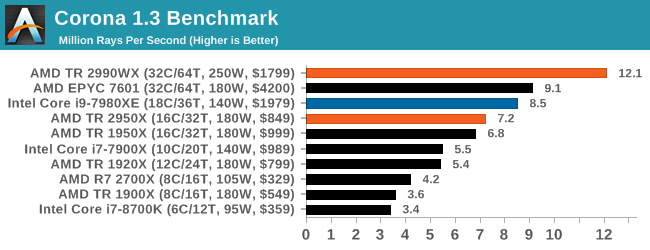
So this is where AMD broke our graphing engine. Because we report Corona in rays per second, having 12 million of them puts eight digits into our engine, which it then tries to interpret as a scientific number (1.2 x 10^7), which it can’t process in a graph. We had to convert this graph into millions of rays per second to get it to work.
The 2990WX hits out in front with 32 cores, with its higher frequency being the main reason it is so far ahead of the EPYC processor. The EPYC and Core i9 are close together, however the TR2950X at half the cost comes reasonably close.
Blender 2.79b: 3D Creation Suite
A high profile rendering tool, Blender is open-source allowing for massive amounts of configurability, and is used by a number of high-profile animation studios worldwide. The organization recently released a Blender benchmark package, a couple of weeks after we had narrowed our Blender test for our new suite, however their test can take over an hour. For our results, we run one of the sub-tests in that suite through the command line - a standard ‘bmw27’ scene in CPU only mode, and measure the time to complete the render.
Blender can be downloaded at https://www.blender.org/download/
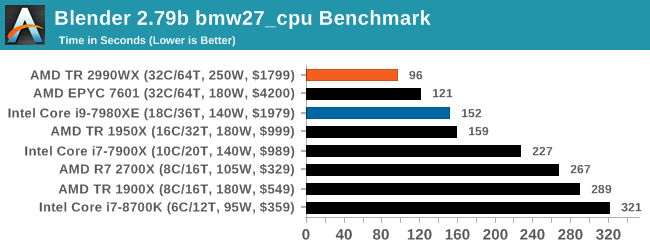
The additional cores on the 2990WX puts it out ahead of the EPYC and Core i9, with the 2990WX having an extra 58% throughput over the Core i9. That is very substantial indeed.
LuxMark v3.1: LuxRender via Different Code Paths
As stated at the top, there are many different ways to process rendering data: CPU, GPU, Accelerator, and others. On top of that, there are many frameworks and APIs in which to program, depending on how the software will be used. LuxMark, a benchmark developed using the LuxRender engine, offers several different scenes and APIs.

Taken from the Linux Version of LuxMark
In our test, we run the simple ‘Ball’ scene on both the C++ and OpenCL code paths, but in CPU mode. This scene starts with a rough render and slowly improves the quality over two minutes, giving a final result in what is essentially an average ‘kilorays per second’.
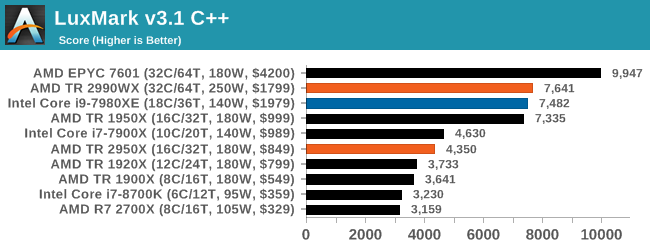
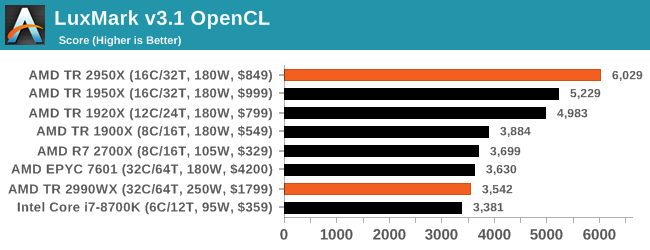
Intel’s Skylake-X processors seem to fail our OpenCL test for some reason, but in the C++ test the extra memory controllers on EPYC sets it ahead of both TR2 and Core i9. The 2990WX and Core i9 are almost equal here.
POV-Ray 3.7.1: Ray Tracing
The Persistence of Vision ray tracing engine is another well-known benchmarking tool, which was in a state of relative hibernation until AMD released its Zen processors, to which suddenly both Intel and AMD were submitting code to the main branch of the open source project. For our test, we use the built-in benchmark for all-cores, called from the command line.
POV-Ray can be downloaded from http://www.povray.org/
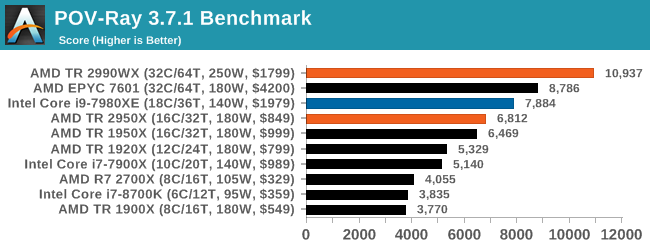
This test is another that loves the cores and frequency of the 2990WX, finishing the benchmark in almost 20 seconds. It might be time for a bigger built-in benchmark.


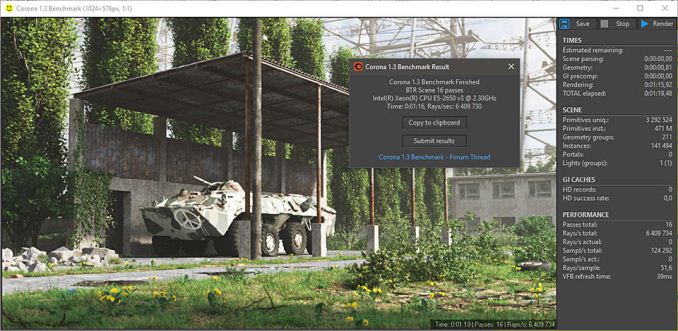








171 Comments
View All Comments
Lolimaster - Monday, August 13, 2018 - link
I don't really see a point OCing the 2990WX, it seems quite efficient at stock setting with an average of 170w fully loaded, why go all the way to 400w+ for just 30% extra performance, it already destroys the 2950X/7980XE OCed to hell beyond repair.Lolimaster - Monday, August 13, 2018 - link
Threadripper 2990WX = Raid Bossyeeeeman - Monday, August 13, 2018 - link
Amazing performance from AMDs part. If you want to see a real review of 2990WX from a reviewer who understands how this CPU will be used, please check https://www.phoronix.com/scan.php?page=article&...mapesdhs - Monday, August 13, 2018 - link
Figured it would be those guys. 8) I talked to them way back when they started using C-ray for testing, after the original benchmark author handed it over to me for general public usage, though it's kinda spread all over the place since then. Yes, they did a good writeup. It's amusing when elsewhere one will see someone say something like, these CPUs are not best for gaming! Well, oh my, what a surprise, I could never have guessed. :DIn the future though, who knows. Fancy a full D-day simulator with thousands of players? 10 to 20 years from now, CPUs like this might be the norm.
eva02langley - Tuesday, August 14, 2018 - link
It is exactly what I said. If we don't have a proper test bed for a unique product like this, then the results we are going to provide are not going to be representative of the true potential of a CPU like this.Sites will need to update their benchmarks suites, or propose new review systems.
Gideon - Monday, August 13, 2018 - link
Great article overall. The Fabric Power part was the most interesting one! Though you might want to check The Stilt's comments regarding that:https://forums.anandtech.com/threads/2990wx-review...
and:
https://forums.anandtech.com/threads/2990wx-review...
Icehawk - Monday, August 13, 2018 - link
Ian, for in progress articles can they please be labelled that way? I would rather wait for the article to be complete than read just a few pages and have to check back hoping it has been updated.mapesdhs - Monday, August 13, 2018 - link
Ian, can you add C-ray to the multithreaded testing mix please? Becoming quite a popular test these days as it can scale to hundreds of threads. Just run at 8K res using the sphract scene file with a deep recursion depth (at least 8), to give a test that's complicated enough to last a decent amount of time and push out to main RAM a fair bit aswell.abufrejoval - Monday, August 13, 2018 - link
Ok, I understand it we are all enjoying this pay-back moment: Intel getting it on the nose for trying to starve AMD and Nvidia by putting chipsets and GPUs into surplus transistors from process shrinks, transistors that couldn’t do anything meaningful for Excel (thing is: Spreadsheets would actually be ideal for multi-cores even GPGPU, you just need to rewrite them completely…)But actually, this article does its best to prepare y’all for the worst: Twice the cores won’t be twice the value, not this time around, nor the next… or the one after that.
Please take a moment and consider the stark future ahead of us: From now on PCs will be worse than middle class smartphones with ten cores, where it’s cheaper to cut & paste more cores than to think of something useful.
KAlmquist - Monday, August 13, 2018 - link
I'm not sure AMD would have bothered with the 2990WX if it weren't for the Intel Core i9 7980XE. With 18 cores, the 7980XE beats the 16 core Threadripper 2950X pretty much across the board. On the other hand, if you running software that scales well across lots of cores--and you probably are if you're considering shelling out the money for a 7980XE--the 32 core 2990WX will be faster, for about $100 less.These are niche processors; I doubt either of them will sell in enough volume to make a significant difference to the bottom line at Intel or AMD. My guess is that both the 2990WX and the 7980XE were released more for the bragging rights than for the sales revenue they will produce.